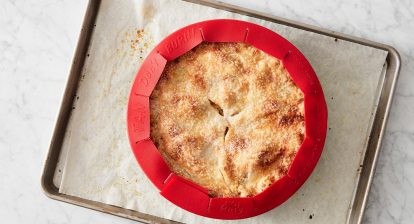Welcome to the world of dough baking, where the process of stretching and folding the dough plays a vital role in creating artisan breads with an irresistible texture and taste. Each stretch and fold brings you closer to achieving a beautiful, airy crumb and a crust that sings with every bite. Let's dive deeper into the art of stretching and folding sourdough.

Table of Contents
Why stretch and fold sourdough?
Stretching and folding sourdough is a basic technique used in bread making for several important reasons.
Development of gluten
Stretching and folding helps develop gluten, the network of proteins responsible for giving bread its structure and elasticity. By stretching and folding the dough, you line up the gluten strands, creating a strong, cohesive dough that can trap the gas produced during fermentation.
Improved quality
The repeated action of stretching and folding contributes to a more uniform crumb structure. It helps create an open, airy interior with well-distributed air pockets, resulting in a lighter, softer loaf.
Even Fermentation
Stretching and folding redistributes the yeast and lactic acid bacteria throughout the dough, ensuring a more even fermentation. This promotes consistent flavor development and helps achieve a balanced color in your sourdough.
Dough strength
As you stretch and fold the dough, it gains strength and texture. This is especially important for highly hydrated doughs, as it improves their ability to hold their shape during proofing and baking.
Added oven spring
Improved gluten development and structure from stretching and folding contribute to better oven spring – the final rise a loaf experiences in the oven. This leads to a fuller, more voluminous loaf with a beautiful crust.
Do I need to stretch and fold the sourdough?
While stretching and folding the sourdough is not absolutely mandatory, it is highly recommended to achieve optimal results.
That is why:
- Improvement of dough handling: Stretching and folding helps firm the dough and develop the gluten, making it more manageable and easier to handle throughout the baking process. It increases the elasticity of the dough and reduces the risk of it becoming too sticky or difficult to shape.
- Improved texture: Stretching and folding promotes an open and airy crumb structure by evenly distributing air pockets throughout the dough. This results in a light, soft and well-textured bread.
- The best oven spring: The strength and structure developed through stretching and folding contribute to better oven spring, resulting in a loaf that rises well during baking. This leads to a more visually appealing loaf with a desirable crust.
- Consistent results: Incorporating stretching and folding into your sourdough routine helps create a more consistent and predictable result. This allows you to better understand your dough and its behavior, enabling you to make adjustments as needed to achieve the desired results.

How to stretch and fold sourdough during bulk fermentation?
Stretching and folding the sourdough during bulk fermentation is a crucial step in gluten development and dough strengthening. Here is a step-by-step guide:
- After the initial mixing and resting period, transfer the dough to a clean, floured surface or to a large bowl.
- Wet hands to prevent sticking. Gently grab one side of the dough and stretch it up without tearing, then fold into the center of the dough. Repeat this process for each side of the dough (top, bottom, left and right), essentially folding the dough in on itself.
- Rotate the dough 90 degrees and repeat the stretching and folding process. This ensures that each side of the dough is stretched and folded evenly.
- If you are working in a bowl, you can do the stretch and fold directly in the bowl by reaching under the dough and pulling one side up and over the center. Rotate the container and repeat for each side.
- Cover the dough with a damp cloth or plastic wrap and let it rest for a set period (usually 30 minutes to 1 hour, depending on your recipe).
- Repeat the stretching and folding process two to three more times during bulk fermentation, keeping consistent intervals between each folding (eg, every 30 minutes to 1 hour).
- After the final stretching and folding, allow the dough to continue its bulk fermentation until it increases in volume and shows signs of fermentation (such as visible bubbles and a slightly puffy appearance).
How many times should you stretch and fold the sourdough?
The number of times you need to stretch and fold your dough during bulk fermentation can vary depending on factors such as dough hydration, recipe, and personal preference. However, a common practice is to perform the stretching and folding technique two to four times during the bulk fermentation stage.
Here are some general guidelines:
- For a dough with moderate hydration (about 65-75% hydration), 3 sets of stretching and folding are commonly used. Do the first set immediately after mixing the dough, then repeat the process every 30 minutes to 1 hour for the next two sets.
- ABOUT dough with higher hydration (over 75% hydration), you can choose 4 sets of stretching and folding. Perform the first set immediately after mixing, then repeat the process every 30 minutes for the next three sets.
It is important to note that the purpose of stretching and folding is to develop the gluten, strengthen the dough and improve its structure. However, overcooking can lead to excessive gluten development and possible loss of fermentation gases.
Therefore, it is recommended to observe the behavior of the dough and adjust the number of stretching and folding cycles accordingly.
Ultimately, the ideal number of stretching and folding cycles will depend on the specific characteristics of your dough and the results you want to achieve. It's always helpful to experiment and adjust based on feedback from your dough during the bulk fermentation process.
How do you know when to stop doing Stretch and Folds?
Knowing when to stop stretching and folding during the bulk fermentation phase of sourdough baking is a skill that comes with experience and understanding the behavior of your dough. Here are some pointers that can help you determine when to stop:
- Dough strength: As you stretch and fold, you will notice that the dough becomes firmer and more elastic. Pay attention to how the dough feels in your hands. When it begins to hold its shape well, resist tearing and feel taut, it indicates that the gluten has developed sufficiently. At this point, you might consider stopping the stretching and folding process.
- Increased volume: Throughout bulk fermentation, the dough should undergo a noticeable increase in volume. This indicates that the yeast is active and fermentation is taking place. As soon as the dough has increased significantly in size and appears puffy, this is a sign that it has undergone sufficient fermentation and you can proceed to the next stage.
- Visual cue: Look for visual indicators of fermentation, such as visible bubbles on the surface of the dough or a slightly domed appearance. These signs suggest that the yeast and bacteria are active and have produced enough gas to contribute to the desired texture and flavor.
- Timing and recipe guidelines: Following the recommended times given in your recipe can be helpful, especially if you are new to sourdough baking. Recipes often provide approximate times for bulk fermentation, and you can adjust the number of stretches and folds accordingly. However, keep in mind that the specific conditions of your environment and the characteristics of your dough may require some flexibility in timing.
How to stretch and fold sourdough bread?
Mastering the technique of stretching and folding sourdough bread can significantly increase your baking skills and improve the quality of your bread. By regularly incorporating this method during the bulk fermentation phase, you can achieve several benefits.
Stretching and folding increases gluten development, resulting in a firmer dough with improved quality and texture. It also promotes fermentation, leading to a balanced flavor and desirable crumb.
For more stretching and folding techniques, here's what you need to know spiral folds of sourdough.
Frequently asked questions
What are Stretch and Folds?
Stretching and folding is a technique used in making sourdough bread to develop the strength of the gluten and improve the texture of the dough. During the process, the dough is gently stretched and folded over at regular intervals during fermentation. This helps create a more elastic and cohesive dough, resulting in a better-textured final loaf.
How does the effect of the autolysis technique extend and fold?
of autolyse the technique, which involves mixing flour and water and allowing it to rest before adding the remaining ingredients, can increase the effectiveness of stretching and folding. Autolysis helps to hydrate the flour and activate enzymesresulting in improved gluten development during the subsequent stretching and folding steps, leading to a more elastic and stretchy dough.
What is the best stretch and fold technique to use?
There are various stretching and folding techniques used in making sourdough bread, and the best one depends on personal preference and the specific recipe. Common techniques include letter folding, spiral folding, and double folding. Experiment with different techniques to find one that suits your dough handling style and produces the desired results.







